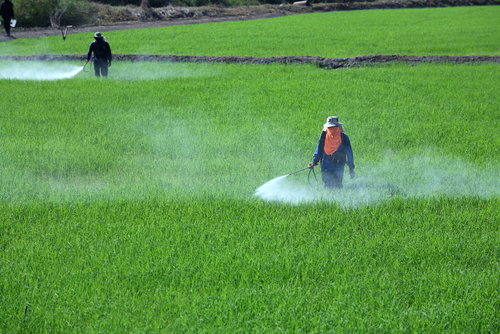New Voluntary Manufacturers Program to Control Pesticide Drift
 |
Pesticides that drift onto neighboring properties increase risk of exposure for human populations in schools, homes, and adjacent fields and can negatively impact water, the environment, and wildlife. Even as the EPA is more strictly regulating pesticides and farmworkers, the reality of pesticide drift or volatilization has remained a problem.
According to the EPA, from 1 percent to 10 percent of pesticides sprayed on agricultural crops drifts from the target crop. That amounts to about 70 million pounds of pesticide active ingredients that are wasted and that can also damage nearby crops and/or make them unsalable if the drifting pesticide is not registered for use on the crop. Pesticide drift events also illicit thousands of complaints of each year to state and local agencies that then must spend resources investigating the complaints.
Pesticide products that are known to drift into unintended areas are classified in two ways:
(1) Pesticide dust formulations or droplets produced by spray nozzles that move through the air during or soon after application, and
(2) Postapplication volatilized pesticide vapors produced by application of the following and resulting in exposure via inhalation:
- Volatile agricultural pesticides (e.g., fumigants),
- Semivolatile agricultural pesticides, and
- Pesticides for indoor pest control.
You won’t find a more thorough and effective course related to hazardous waste operations to help meet the employee training requirements of OSHA’s HAZWOPER regulation than BLR’s HAZWOPER Training Program®.
Initially, EPA’s Drift Reduction Technology (DRT) Program will focus primarily on testing drift-reduction effectiveness of spray technologies that are used to apply pesticides to row and field crops by ground or aerial equipment. The technologies include:
- Nozzles,
- Spray shields, and
- Drift-reducing chemicals (i.e., chemicals added to improve the performance of the product).
The program will use a four-star drift reduction rating system to categorize the level of drift reduction for each tested technology that meets the minimum standard of 25 percent reduction in potential spray drift as compared to the test standard nozzle. The greater the number of stars, the greater the potential reduction of spray drift. The rating system will assess and rank each technology’s DRT effectiveness as follows:
- One star—25% – 49% reduction
- Two stars—50% – 74% reduction
- Three stars—75% – 89% reduction
- Four stars—90+% reduction
Your Search for HAZWOPER Training Is Over—We Guarantee It!
You won’t find a more thorough and effective course related to hazardous waste operations to help meet the employee training requirements of OSHA’s HAZWOPER regulation (29 CFR 1910.120) than BLR’s HAZWOPER Training Program. Your training materials include a DVD, a 200+page HAZWOPER training manual with tests, handouts, and an electronic version on CD! Handy outline tells you exactly what to present and when to meet either the 8-, 24-, or 40-hour requirements. Learn more.
Those manufacturers that would like to take part in the voluntary DRT program may conduct their own studies, preferably using EPA’s testing protocols, which include three approaches:
- Low-speed wind tunnels (to simulate application by ground boom equipment),
- High-speed wind tunnels (to simulate application by aircraft), and
- Field testing (groundboom or aerial applications).
More information about how to participate in the DRT program for equipment manufacturers is available at http://www2.epa.gov/reducing-pesticide-drift/how-test-pesticide-spray-technologies-drift-reduction.
To implement the DRT in actual practice, pesticide manufacturers participating in the program will add DRT instructions to product labels and can choose to label products with both DRT and non-DRT application restrictions. The EPA implies that fewer restrictions may be placed on those pesticide products that must be used in conjunction with DRTs than will be placed on pesticides used without DRTs.
The EPA anticipates that DRT ratings could begin appearing on pesticide labels as early as fall 2015, and will be placed in the area of the label defining directions for product use. According to the EPA, adoption of the DRT program and subsequent widespread use of DRTs by pesticide applicators will help not only to reduce pesticide drift but also “will provide a standardized, verified system” for doing so.
Pesticide product manufacturers can learn more about the labeling program and requirements at http://www2.epa.gov/pesticide-registration/pesticide-registration-manual-chapter-6-amending-registered-pesticide-product.
